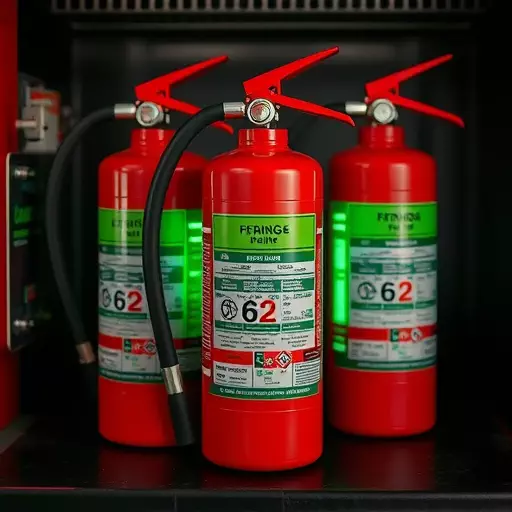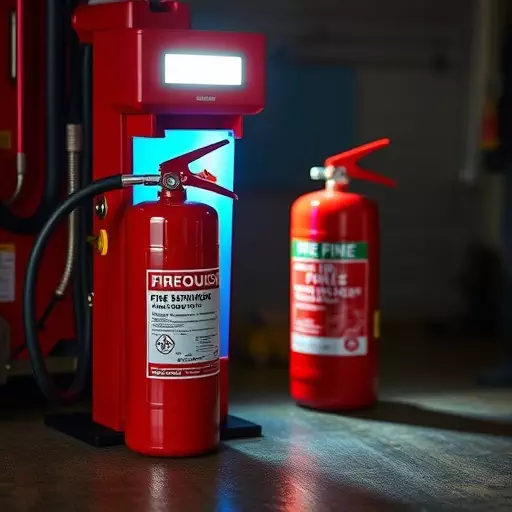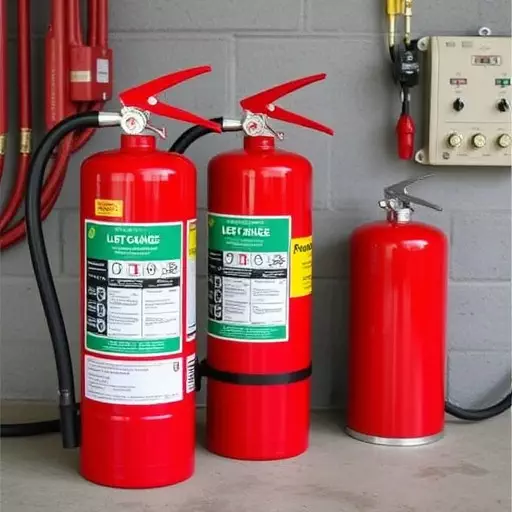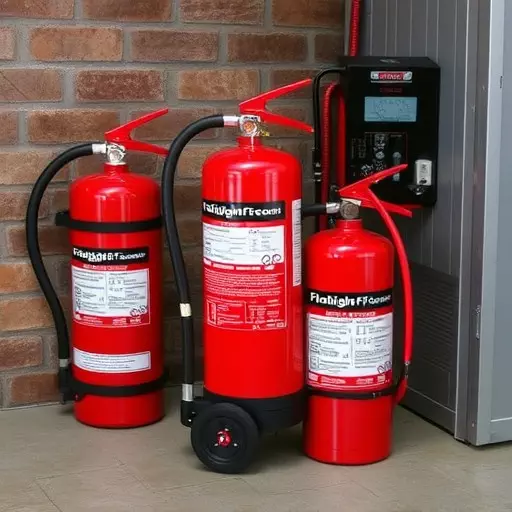In commercial kitchens, proper fire extinguisher recharge is paramount for safety. This includes understanding different types like ABC and CO2 extinguishers, their recharge methods (on-site or professional), and adherence to manufacturer guidelines. Regular maintenance, timely recharging, and compliance with local regulations ensure extinguishers are ready for immediate use in emergencies, such as fire suppression by CO2 models every 3-5 years. Professional services in Fayetteville cater to diverse recharge needs, enhancing kitchen safety and avoiding penalties.
“In commercial kitchens, where fires pose a significant risk, proper fire extinguisher recharge and maintenance are non-negotiable. This comprehensive guide delves into the essential aspects of fire extinguisher recharge, specifically focusing on portable units and CO2 extinguishers.
From understanding different extinguisher types and their recharge needs to navigating local regulations in Fayetteville, this article provides a step-by-step process for business owners to ensure safety and compliance. Learn about the benefits of regular maintenance and crucial considerations for CO2 fire extinguisher recharge.”
- Understanding Fire Extinguisher Types and Recharge Needs in Commercial Kitchens
- The Process of Fire Extinguisher Recharge: A Step-by-Step Guide
- Benefits of Regular Portable Fire Extinguisher Recharge
- CO2 Fire Extinguishers: Recharge, Maintenance, and Safety Considerations
- Local Regulations and Compliance for Fire Extinguisher Recharge in Fayetteville
Understanding Fire Extinguisher Types and Recharge Needs in Commercial Kitchens

In commercial kitchens, fire safety is paramount. Understanding the different types of fire extinguishers and their specific recharge needs is crucial for effective protection. Portable fire extinguishers, a common sight in many kitchens, come in various classes, each designed to combat different types of fires. Dry chemical (ABC) extinguishers are popular for kitchen fires due to their effectiveness against grease and electrical blazes. Carbon dioxide (CO2) extinguishers, another option, are ideal for environments with sensitive electronics or where water damage needs to be minimized.
Knowing when to recharge these critical devices is essential. Portable fire extinguisher recharge processes vary depending on the type. For instance, CO2 extinguishers typically require a professional recharge service due to the pressure system involved. In Fayetteville, local fire safety companies offer convenient portable fire extinguisher recharge services, ensuring your kitchen is prepared in case of an emergency. Regular maintenance and timely recharging, adhering to manufacturer recommendations, are vital to guarantee optimal performance when it matters most.
The Process of Fire Extinguisher Recharge: A Step-by-Step Guide

Fire extinguisher recharge in commercial kitchens is a crucial safety measure often overseen but essential for effective emergency response. The process, particularly for CO2 fire extinguishishers and portable models, involves several precise steps to ensure their optimal functioning when needed most. Here’s a step-by-step guide tailored for Fayetteville businesses:
1. Preparation: Begin by assessing all available fire extinguishers in your commercial kitchen. Ensure they are accessible, undamage, and within their recommended expiration date, which is typically 5-12 years depending on the type. For CO2 extinguishers, visual checks include inspecting the gauge for any signs of damage or corrosion.
2. Evacuate the Area: Safety first! Before recharging, clear a safe workspace around the extinguisher. This step is vital in Fayetteville commercial kitchens due to potential gas emissions during the recharge process. Ensure proper ventilation and keep personnel at a safe distance until the recharge is complete.
3. Discharge Pressure: For CO2 extinguishers, discharge pressure testing is crucial. Release the pressure valve to ensure the extinguisher operates correctly and there are no leaks. This test also allows for any necessary adjustments before recharging. Portable fire extinguishers may require similar pressure checks depending on their design.
4. Recharge or Replace: If the extinguisher shows signs of depletion (gauge indicates low pressure), it’s time for a recharge. For CO2 models, this involves refilling with compressed carbon dioxide gas to the proper PSI. Portable extinguishers might use different recharge methods based on their type (water, dry chemical, etc.). Always follow manufacturer guidelines and consider professional assistance when in doubt.
5. Re-inspection: After recharging, re-inspect the extinguisher for any signs of damage or correct operation. Ensure it is firmly secured in its mounting bracket. Once satisfied, relabel the date of recharge to track maintenance intervals, which are critical in maintaining their effectiveness.
Benefits of Regular Portable Fire Extinguisher Recharge

Regular portable fire extinguisher recharge is an essential practice for commercial kitchens in Fayetteville, offering numerous advantages that contribute to a safer and more secure environment. The process involves the meticulous refilling and testing of these critical safety devices, ensuring they are ready to deploy when needed. One significant benefit is extended longevity; proper recharge cycles extend the lifespan of fire extinguishers, reducing the need for frequent replacements.
Additionally, scheduled recharges maintain optimal performance. CO2 fire extinguisher recharge, in particular, guarantees that the extinguisher’s contents remain at the required pressure level, enabling quick and effective suppression in case of a fire. This proactive approach to maintenance allows businesses to stay ahead of potential hazards, providing peace of mind and compliance with local safety regulations for commercial kitchens in Fayetteville.
CO2 Fire Extinguishers: Recharge, Maintenance, and Safety Considerations

Fire extinguishers are a critical safety measure in commercial kitchens, and CO2 (carbon dioxide) models are particularly popular due to their effectiveness in suppressing grease fires. The recharge process for these fire extinguishers is essential to ensure they remain operational and ready when needed. In Fayetteville, the recharge of portable CO2 fire extinguishers should be scheduled regularly, typically every 3-5 years, depending on usage and local regulations. This involves refilling the tank with dry ice (solid carbon dioxide) and ensuring all components are in good working order.
Proper maintenance includes inspecting for any signs of damage or corrosion, checking the pressure gauge, and verifying that the discharge nozzle is clear. During recharge, trained professionals follow specific procedures to avoid any safety risks associated with high-pressure systems. Regular CO2 fire extinguisher recharge not only keeps your kitchen ready for emergencies but also ensures compliance with building codes, making it a crucial aspect of overall fire safety in Fayetteville commercial spaces.
Local Regulations and Compliance for Fire Extinguisher Recharge in Fayetteville

In Fayetteville, the fire safety regulations regarding commercial kitchens are strictly enforced to ensure the safety of all occupants and comply with local codes. One critical aspect of this is the regular recharge of fire extinguishers, which must be performed by certified professionals according to the specific requirements outlined in the local ordinances. The fire extinguisher recharge process in Fayetteville involves a systematic evaluation and replenishment of portable fire extinguishers, focusing on both safety standards and environmental considerations.
For businesses operating within the city limits, it’s crucial to understand that different types of fire extinguishers, such as CO2 fire extinguishers, require distinct recharge methods. Portable fire extinguisher recharge services in Fayetteville are designed to accommodate these variations, ensuring each device is serviced appropriately. Compliance with these regulations not only protects against potential penalties but also plays a vital role in maintaining a safe and secure cooking environment.


